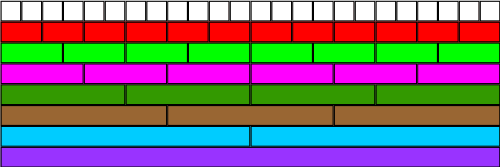Copyright © University of Cambridge. All rights reserved.
'Fractions Made Faster' printed from https://nrich.maths.org/
Show menu
Having a visual representation of fractions as a wall will aid children's understanding of both equivalent fractions and comparisons of fractions, but perhaps it will also equip them with a method to help them in the future. It is important that pupils have an appreciation of what is being taken as "the whole" and this may need some discussion before the problem as it stands is tackled. Using real Cuisenaire rods to aid manipulation of fractions is invaluable, although the lengths pose some restrictions. However, OHT rods could be used as a way into the problem by concentrating on just a few different lengths to start with.
This could be used to help older children to understand the concepts necessary for manipulating fractions to add and subtract them. It is amazing how much easier the visualisation makes the arithmetic process. Just try it yourself and see.
